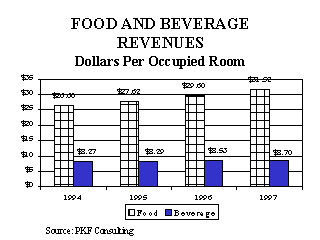| by Patrick Quek, December 1998
The recovery of the hotel industry since the doldrums of the early 1990s
has been well documented. At first, limited new construction lead
to steady growth in occupancy from year to year. Then, starting in
1994, the favorable balance of supply and demand allowed hotel managers
to raise their room rates two to three times the pace of inflation.
The net result has been a doubling of property level profits from 1991
to 1997.
Certainly, the strong growth in room rates has been the major impetus
behind the rise in profits. However, not as frequently discussed
has been the tremendous growth in profits generated by food and beverage
departments. With total food and beverage revenue growing 17.7 percent,
and expenses growing at only 9.6 percent, f&b department profits have
grown 54.5 percent from 1994 to 1997. Long thought of as a break-even
operation at best, hotel food and beverage departments are now providing
a significant contribution to the bottom line of a hotel.
 Please Pass The Potatoes
Please Pass The Potatoes
Analyzing the detail, it is obvious that the majority of the improvement
in department profitability has come from the sale and preparation of food,
as opposed to alcoholic beverages.
Food revenues (not including other income), measured on a per-occupied-room
basis, have grown 18.5 percent from 1994 to 1997. This growth rate
does fall short of the 25.1 percent growth rate in ADR during the same
period. However, it is still a remarkable statistic, considering
the number of full-service hotels that have cut their number of outlets,
limited their hours of service, or adopted other forms of food service
(food courts, leased restaurants, etc.).
Concurrent with the rise in food sales has been a decline in the food
cost percentage. From 1994 to 1997, the cost of food sold has declined
from 30.9 percent of sales to 29.4 percent. This decline can be attributed
to a shift towards serving items with a lower cost, as well as greater
controls. Menus historically dominated by high-cost steaks and chops
have been replaced with lower-cost, healthy items (salads, poultry, fish)
and popular/familiar foods (wraps, hamburgers, home-cooking).
Hold The Wine
Following the change in social habits, the growth in alcoholic beverage
sales has been much more limited than the growth in food sales. Since
1994, beverage sales at hotels have grown a mere 5.2 percent when measured
on a per-occupied-room basis. Unfortunately, the dollars a hotel
spends to purchase the alcohol sold has increased 8.1 percent during the
same period. Once an easy profit center for most hotels, hotel lounges
are becoming less of a source for automatic money.
Still Serving On A Silver Platter
As creative as hotel food and beverage directors have become adjusting
their menus, hours of operation, ambiance, and marketing techniques, the
one component of food and beverage service that still remains rather large
is labor. Total labor costs in the food and beverage department have
remained relatively constant at approximately 42 percent from 1994 to 1997.
Like overall labor costs for hotels, total payroll and benefits in the
food and beverage department have averaged a 4.2 percent annual growth
rate since 1994. This rate of growth is approximately twice that
of the national average annual growth rate for labor costs in all industries.
Until hotels and restaurants are able to produce and serve meals with a
�Jetsons-like� machine, the personal touch will always be a major component
of food and beverage production and service.
Other Costs In Check
Labor expenses and cost-of-goods-sold have historically been identified
as the �prime costs� of operating a food and beverage department.
Together, these two expenses have grown 15.5 percent between 1994 and 1997.
During this same period, however, all the other costs associated with the
operation of the food and beverage department have actually declined from
$1,344 per-available room in 1994 to $1,070 in 1997. These other
expenses include such items as laundry, china, glassware, silver, linen,
and entertainment. It is apparent that restaurant, lounge, and banquet
managers have focused on cutting expense items that are mostly fixed in
nature.
The rental of guest rooms will continue to be the major source of income
and profits for hotels that offer food and beverage service. Therefore,
it is practical that the greater portion of management�s time and resources
should be allocated to the rooms department.
Since the recession of the 1990s, hotel owners have become much more
sensitive to the fiscal health of their properties and no longer tolerate
losses from any of the operating departments. Therefore, food and
beverage managers will need to continue their effective turnaround of this
area of the hotel that has historically been ignored and overlooked.
Selected Food
and Beverage Growth Rates
1994 to 1997
| Total F&B Revenue |
17.7% |
| Salaries and Benefits |
16.7% |
| Total Department Expenses |
9.6% |
| Department Profits |
54.5% |
Food and Beverage
Department Profits
Percent of Department Revenues
| 1997 |
23.7% |
| 1996 |
21.6% |
| 1995 |
19.2% |
| 1994 |
18.0% |
Food and Beverage
Cost of Goods Sold
Percentage of Revenue
|
Year
|
Food
|
Beverage
|
| 1997 |
29.4% |
23.6% |
| 1996 |
30.0% |
23.6% |
| 1995 |
30.7% |
23.3% |
| 1994 |
30.9% |
22.9% |
Patrick Quek is president and CEO of PKF Consulting, an international
hospitality consulting firm headquartered in San Francisco. |